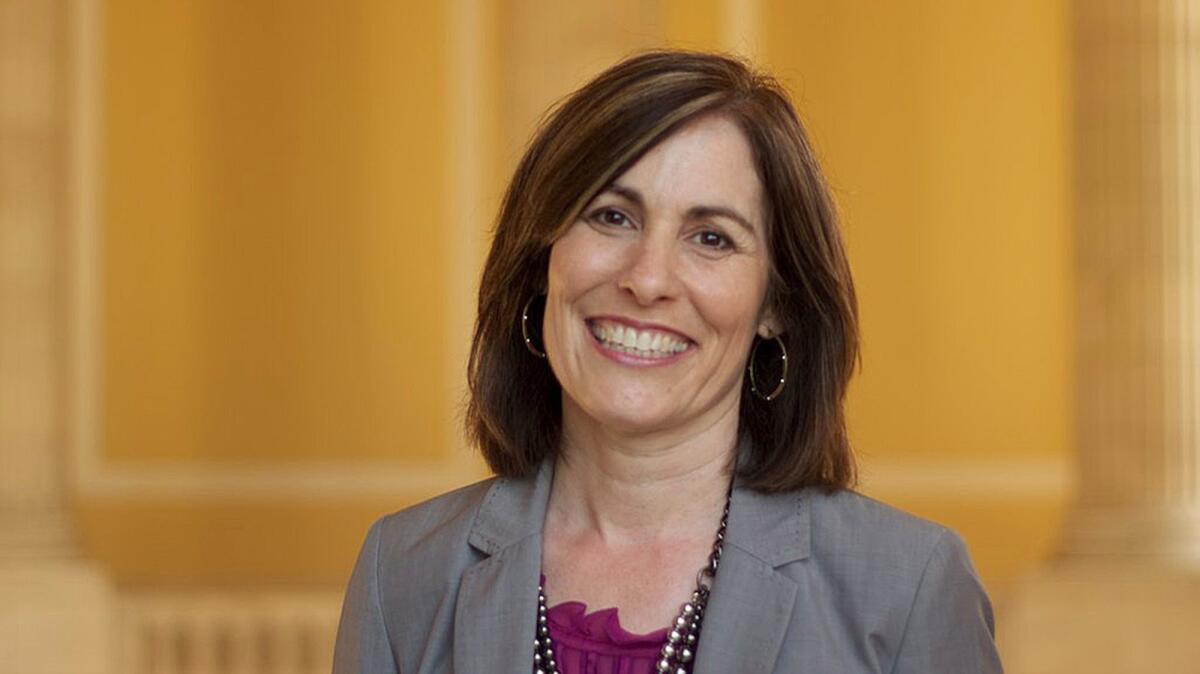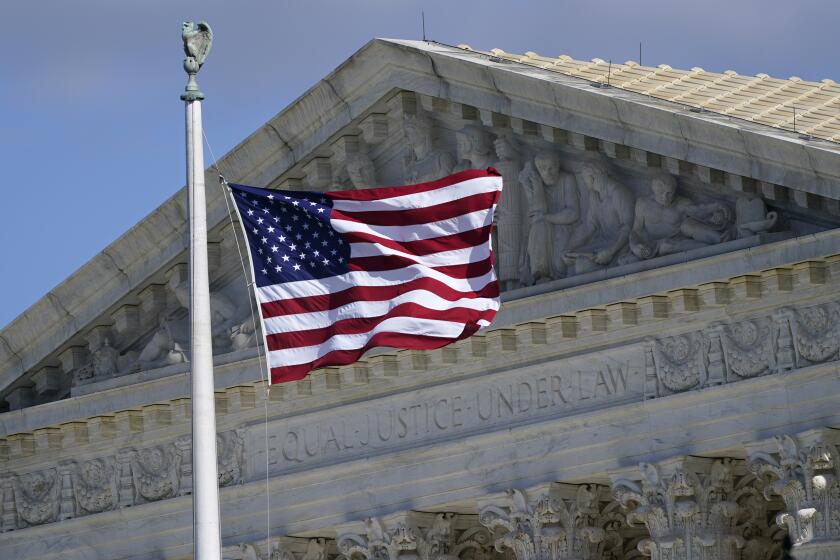Column: Trump makes good on a threat to kill teen pregnancy prevention programs

- Share via
Experts in teen pregnancy prevention were nervously holding their breaths as the Trump administration stocked key positions at the Department of Health and Human Services with advocates of ineffective abstinence-only sex education programs and opponents of birth control.
Now their fears have proven to be justified. Over the last couple of weeks, 81 teen pregnancy programs around the country have been informed that their grants will end in the next fiscal year, or as of June 30, 2018. At least one program that funded educational outreach by Childrens Hospital of Los Angeles, among other institutions, was cut off immediately — just as it was beginning the second year of a five-year plan. In all, more than $200 million in annual funding is being ended, according to an analysis by the Center for Investigative Reporting, which made the shutdown public.
In most cases, the grantees were unaware that their programs were under a death sentence until they received their formal annual notices at the start of the grant year, July 1.
We’d been expecting that funding could be cut. But we didn’t think it would happen this way, and expected that there would be discussion about it.
— Luanne Rohrbach, USC
Some of the notices were chilly indeed. “Due to changes in program priorities, it has been determined that it is in the best interest of the Federal government to no longer continue [your] funding,” read a July 5 letter sent to Meagan Downey, the head of Vermont-based Youth Catalytics, which has been coordinating a project involving Childrens Hospital of L.A. and four other institutions, including the University of Michigan and the University of Massachusetts. She says the notice blindsided her, because as recently as last month the program had been praised by federal officials.
“There’s been no substantive change in the federal government’s ‘best interest,’” Downey told me. “The only thing that has changed is the appointment of some very extreme, misinformed appointees in HHS.”
She’s referring to a gang of three extremists whose views I outlined in a column in mid-June. They’re Charmaine Yoest, the former head of a prominent anti-abortion group who is now assistant secretary for public affairs at the Department of Health and Human Services; Teresa Manning, a former lobbyist for the National Right to Life Committee and legislative analyst for the Family Research Council who is deputy assistant secretary for population affairs; and Valerie Huber, the former president of Ascend, a Washington group that advocates for abstinence-only sex education, who is chief of staff to the assistant secretary for health.
Yoest’s group has promoted the claim that abortion increases a woman’s chance of breast cancer and of “serious mental health problems.” Both claims have been conclusively refuted by medical science. Manning stated during a 2003 NPR interview, “Of course, contraception doesn’t work. … Its efficacy is very low.” In fact, hormonal methods are 91% effective, and IUDs are 99% effective.
As a promoter of abstinence-only sex education, Huber’s approach has been moralistic, not empirical. “As public health experts and policymakers, we must normalize sexual delay more than we normalize teen sex, even with contraception,” she told PBS last year. But studies consistently show that what reduces teen pregnancies is increased use of contraceptives.
Department of Health and Human Services didn’t acknowledge that these appointees’ personal views had anything to do with the nationwide funding cutoff. Instead, according to an email I received from department spokeswoman Diane Gianelli, “the President’s FY 2018 Budget eliminated funding for the Teen Pregnancy Prevention Program, so our grants office informed the grantees of their June 30, 2018, end date, to give them an opportunity to adjust their programs and plan for an orderly closeout.”
The problem there is that the president’s budget is merely a proposal. It hasn’t been enacted by Congress, so there’s no evidence that the lawmakers concur with his priorities.
“We’d been expecting that funding could be cut,” says Luanne Rohrbach of the Keck School of Medicine at USC, which is in the third year of a $10-million grant to provide educational outreach to as many as 20,000 teens in South Los Angeles and Compton who are at risk for unintended pregnancies. “But we didn’t think it would happen this way, and expected that there would be discussion about it. We thought there would be an opportunity at least for the program to be deliberated.”
The programs being shut down by Trump’s Health and Human Services Department were the product of a major push by the Obama administration for evidence-based approaches to social problems such as teen pregnancy. The idea was to use scientific methods to identify what worked, and apply them in the field. Rohrbach’s program, which has been operating on a second five-year grant after receiving a first grant in 2011-2015, is the largest in California and one of the largest in the country.
The program brings comprehensive sex education to students in middle schools in the L.A. Unified and Compton school districts, teaching them everything from anatomy to how to choose high-quality friendships, resist offers of sex if they’re not interested, and avoiding STDs through contraception. One part of the program is directed at the parents of at-risk children.
The program “absolutely presents abstinence as a favorable option,” Rohrbach says, but recognizes that it’s not enough. A great deal of evidence suggests that programs emphasizing abstinence can work, but abstinence-only programs don’t. “This is what people with certain political beliefs who have an agenda don’t quite understand,” she says.
Opponents of such educational programs sometimes argue they’re ineffective, but also that they’re unnecessary. That’s because teen pregnancy rates have been coming down in the U.S. for years — and especially since the advent of the Affordable Care Act, which vastly expanded the availability of contraceptives, typically at no cost.
The decline of rates in general involves a couple of factors. One is that the decline in rates is at least partially the result of programs like these. “One reason people in the field see a difference is that far more attention is being paid to the issue, and to the kinds of interventions we know will work,” Rohrbach says.
Another factor is that the pregnancy rates for some teens in some socio-economic environments are still way out of line with the national average. Figures from the Centers for Disease Control and Prevention, which document a decline in the national teen birth rate to 22.3 births per 1,000 women aged 15 to 19 in 2015 from 41.5 in 2007, also show that the rates among black, Hispanic, and American Indian/Alaska native teens remain stubbornly higher than the national average, which itself shows that nearly a fourth of U.S. women give birth before they’re 20.
According to data from the Los Angeles County Department of Public Health, the birth rate for women 15 to 19 in the health planning district that includes South L.A. and Compton is 44.3 per 1,000 females in that age range. That’s nearly twice the rate of the county as a whole (22.8) and the national average. As Rohrbach observes, that district is burdened by many poor health and socioeconomic indicators, including lower educational levels, more poverty, poorer health generally, and higher chlamydia rates among teens than any of the county’s other seven health planning districts.
Eliminating the funds for prevention programs isn’t only bad policy from a social standpoint, it’s pound-foolish. Adam Thomas of Georgetown University showed in 2012 that such programs pay for themselves many times over. Every dollar spent returned from $2.50 (for evidence-based teen pregnancy interventions) to $5.60 (for expanded access to Medicaid family planning services).
Nothing could be more damaging to these crucial programs than their abrupt defunding. Although Rohrbach’s program will still have funds through next June, the momentum it has built over eight years, during which it planned for a steady expansion to more schools serving more students, will wither away. “Obviously,” she says, “we’re not going to be able to grow.”
Rohrbach says a conference call has been scheduled for later this week among some of the grantees and Health and Human Services officials, but she doesn’t hold out much hope for a reprieve. If it were a question of money or empirical results, perhaps some appeal could be based on budgetary principles or hard data.
But the presence at the department of ideologues such as Yoest, Huber, and Manning suggests that isn’t the case. Their history suggests, instead, that they’re invulnerable to facts. Trump signaled the threat to evidence-based teen pregnancy intervention by placing them near the top of the Health and Human Services hierarchy, and now that threat has become reality.
Keep up to date with Michael Hiltzik. Follow @hiltzikm on Twitter, see his Facebook page, or email [email protected].
Return to Michael Hiltzik’s blog.
More to Read
Get the L.A. Times Politics newsletter
Deeply reported insights into legislation, politics and policy from Sacramento, Washington and beyond. In your inbox three times per week.
You may occasionally receive promotional content from the Los Angeles Times.











